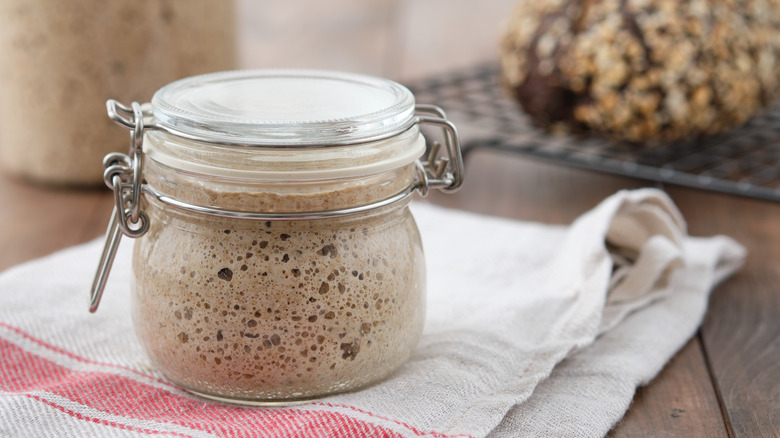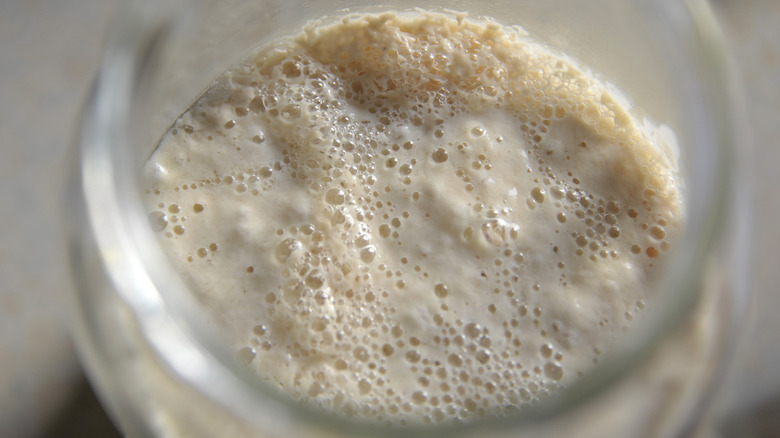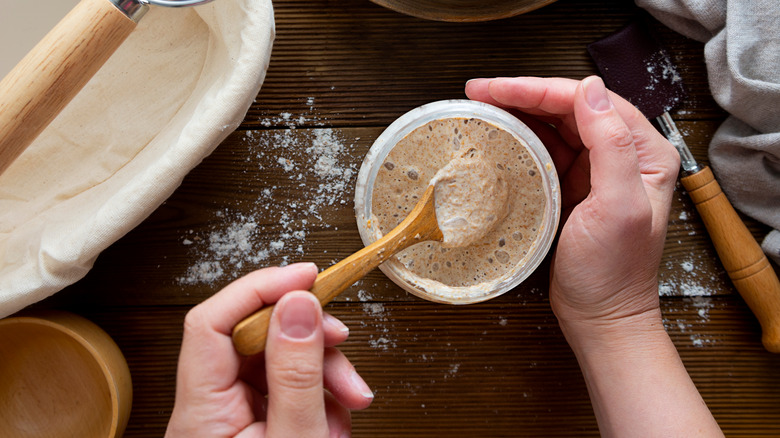The Reason You Always Need A Backup Starter For Sourdough Bread
A labor of love is still a labor, and that certainly applies to making sourdough. But the rewards are worth the effort in multiple ways. Of course, you'll end up with freshly-baked bread — and once you've tried that, it's hard to go back. But sourdough is unique in its nutritional properties as well as its tangy flavor.
BBC Good Food explains that the fermented starter used to make sourdough makes it easier for your body to process the fiber and minerals present in the grain, making it easier to digest than most commercial bread.
But sourdough is notoriously laborious to make, as you need to feed your sourdough starter every day to keep it alive and bubbly. It's a bit like a pet fish — it mostly hangs out doing little to nothing, but it still demands daily care. Failure to feed your starter regularly can cause it to die, meaning you'll have to make a brand-new starter from scratch. The one way around this is to keep a backup starter you can break out if something goes awry.
What happens if you don't have a backup starter?
A sourdough starter is a miniature ecosystem inhabited by a variety of microorganisms that feed on the natural sugars present in flour. Per Scientific American, the most important of these organisms is yeast, which makes the bread rise, and lactic acid bacteria, which gives sourdough its sour flavor and protects against mold. But like all living things, these microorganisms have limited lifespans.
If you properly tend to your starter, it can reproduce indefinitely. According to BBC Travel, there are sourdough starters in use today that date back to the 1800s; with proper care, you could pass your sourdough starter down to future generations. (On the other hand, if all of the microbes in your starter cease reproduction and die, you'll have to start from scratch.)
According to King Arthur Baking, there are two things that can kill your sourdough starter: heat and neglect. The company recommends keeping your starter at a temperature as close to 70 F as possible. If you neglect to feed your starter for multiple days in a row, the good bacteria that protect it can die, allowing mold to grow. And it's essential to feed your starter regularly so the yeast and bacteria have plenty of starch to feed on. Ace Bakery warns that without constant refreshing, the microbes can run out of sugar to eat and starve.
How to preserve your backup starter
Thankfully, keeping a backup sourdough starter doesn't require you to make a new one from scratch. As Cook's Illustrated points out, every time you feed your starter, you're left with excess starter that you'll usually discard. Instead of doing that, save the excess in a separate jar to provide a backup to your primary starter. You can save the backup in the refrigerator, so you don't have to feed it every day. Refrigerated starter only needs to be refreshed once a week, but to preserve it properly, Southern Living urges bakers to cover the starter with a tight lid, as opposed to the loose covering you'd use at room temperature.
For long-term storage, you can dry your starter using a method from King Arthur Baking. Spread your backup starter on a piece of parchment paper as thinly as possible. Let the sheet of starter dry at room temperature, which could take anywhere from one day (if you live in a dry climate) to five days (in a humid climate). By the time the starter is completely dry, it should have lost about half of its original weight. Peel it off the parchment, break it into pieces, and seal it in an airtight container.
Kept in a cool, dark place, such as a pantry, a dried sourdough starter can survive for months or even years on end. If you need to use some of the dried starter, simply rehydrate it in water.


